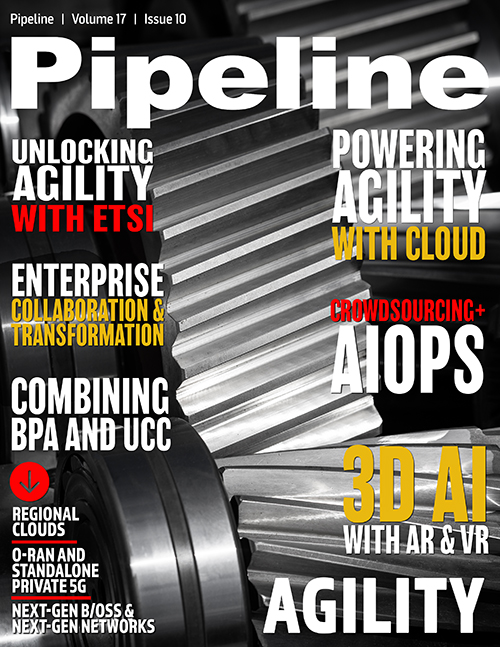Letter from the Editor: Possibilities

Anything is possible, or so they say, and it’s usually said with optimism. But, it’s important to note that “anything” means “anything” which can be either good or not good. Only time will tell.
Looking back over the last year and half – give or take – there a lot of takeaways. In the before times, like 2019, the likelihood of a novel virus causing a global pandemic was among the least of our worries. Now it’s on the top of our minds and virtually a part of every conversation we have. However, if you subscribed to the truest sense of the phrase, you would have been prepared, for just about anything.
It’s a world of possibilities, then and even now. Possibilities are probable outcomes, options, or alternative scenarios. Agility then becomes decisions based upon the available options in the context of the possible outcomes. This can require a bit of vision. Even if a global pandemic was not on your radar, we did know and see the work-from-home and gig-economy trends emerging years before Covid. If you didn’t pick up on those, disaster preparedness should have led you to build better redundancy, resiliency, and agility.
Today is rife with possibilities. For example, the pandemic could get worse. Recent reports from D.C., the NFL, Massachusetts, and Israel show an alarming uptick in breakthrough cases of the Delta variant in fully vaccinated people. In Washington D.C., Virginia, Pennsylvania, Delaware and West Virginia breakthrough cases have been reported to be over 40 percent, with some recent reports as high as 74 percent – consisting of a mix of people who received one of the three predominant vaccines (Moderna, Pfizer, and J&J). To make matters worse, of the roughly 6,000 breakthrough infections in Massachusetts, nearly 100 fully vaccinated people have died. While the numbers support that vaccines do prevent severe disease in most cases, these new data seem to indicate we may see 50/50 odds of getting The Delta Covid variant – whether you are vaccinated or not – and having the same chances of dying from it if you do contract the disease (2 percent).
This puts us in quite a pickle, because more asymptomatic and less severe illness in vaccinated people can mean more spread of the Delta variant (due to its 1000x viral load) to say, children who are ineligible for the vaccine. And, that’s not even considering the next variants, Lambda or Gamma, which show more mutations and a possible resistance to antibodies which the vaccines rely upon to be effective. But you have options.
For starters, vaccinated or not, you could and probably should dust off the ol’ n95 and start wearing it again outside of your immediate pod, and whenever in public, indoors, or at large congregations of people. You could also get one of several vaccines that have been proven effective in large part to prevent severe disease, hospitalizations, and death. Or, you could do both.
But that is not the only possible outcome. The pandemic could actually get better. Viral mutations do not always make them worse. After all, in order for them to survive their host must too. In India, where the Delta variant was first reported, case counts have already declined 31 percent and deaths have dropped 64 percent. But doing nothing isn’t being agile, in fact it’s simply irresponsible.
As you weigh the options in the context of the possible outcomes, will you be agile? With a little vision, many enterprises transformed to contend with the ongoing pandemic. From the small pub who started selling their own hand-sanitizer concoction when they were shut down, to restaurants and retailers who made one-hour delivery to your door a reality, or enterprises both large and small who put the infrastructure in place to enable employees to work from home and work safely in the office, businesses have transformed. The question is where do we go from here, and that’s why this issue of Pipeline is so important.
In this issue of Pipeline, we explore the topic of Agility. Zeetta Networks tells us how enterprise collaboration can fuel transformation and spur innovation. GridRaster shows us how AI is being used for 3D CAD, augmented reality (AR), and virtual reality (VR). Radisys discusses how enterprises are leveraging O-RAN to build 5G standalone private networks. LightRiver walks us through how crowdsourcing and AIOps can be combined to create a powerful ecosystem for innovation. VOSS Solutions demonstrates the combined power of Business Process Automation (BPA) and Unified Communication and Collaboration (UCC) solutions. ADVA illustrates how NFV and cloud are being used to unlock agility in optical networks. ETSI discusses how standards development is unlocking interoperability and agility for connected cars, 5G and other use cases. Dr. Mark Cummings shows us how regional clouds may be the answer to many regional, regulatory, and cultural concerns, and Global Convergence Solutions explore the reasons why next-gen networks need next-gen B/OSS and voice interconnect management. All this plus the latest technology industry news and more.
We hope you enjoy this and every issue of Pipeline,
Scott St. John
Managing Editor
Pipeline
Follow on Twitter | Follow on LinkedIn | Follow Pipeline![]()



















